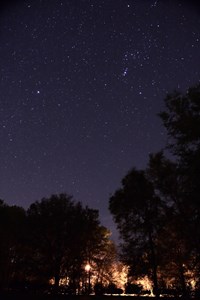 |
ORION THE HUNTER FROM GAINESVILLE IN 2009
ORION Appears Over S.W. Gainesville. Orion (the "Hunter") is one of the large constellations and possibly the most conspicuous. It appears here over a Gainesville, Florida suburban street about eight miles southwest of the University of Florida Campus. Look at the top right. Orion has the shape of a large rectangle with three stars in the middle forming Orion's belt. Three more stars hang down from the belt forming his sword. The middle star appears slightly fuzzy because it is actually the famous Orion Nebula. Photo was taken about eight miles southwest of the university campus (Ben Hill Griffin Stadium ) from a suburban community (2009 May 29). Location: Gainesville, Florida. Photo Details: Canon DSLR EOS 5D II, fixed mount. Canon 28-135mm f/3.5-4.5 IS USM Lens at 29mm. Exp. 20s @ f/4.5 (ISO Equiv. 4000).
|
|
 |
A WINTER SKY FROM SUBURBIA IN 2013
A Beautiful Florida Winter Sky Sans Geminids Photo taken 21 hours before Geminid Meteor Shower Maximum. Unfortunately no Geminids appeared in camera's field of view during the few hours before sunrise. However, a beautiful winter sky hovered over the western horizon with lots to see. Glorious Jupiter shines in Gemini with Gemini's Pollux (left) and Castor (right) above. Below is Orion with yellowish Betelgeuse at upper left and whitish Rigel at lower right. Orion's belt points left toward brilliant Sirius in Canis Major with Canis Minor's Procyon appearing above. Orion's sword sports the fuzzy patch that is the Orion Nebula. Yellowish Aldebaran in Taurus appears near the right edge above the tree line. Lepus is also above the trees just below Orion. The head of Hydra sticks out from the upper left corner. Can you find the Praesepe or Beehive Star Cluster (M44) at the top edge just left of center? And do more stars seem visible horizontally across the midsection of the photo? These stars are in the winter Milky Way Band. Despite a location only six miles S.W. of the University of Florida's Cultural Plaza and lingering horizon clouds that occasionally moved upwards during morning hours, the camera revealed stars down to nearly magnitude +9 with a 30-second exposure and no tracking. (This produced some slight star trailing which reduced the limiting magnitude.) Seeing was very good with little scintillation. Photo Location: S.W. Gainesville Environs, Florida. Photo Details: Canon DSLR EOS 5D II, fixed mount. Canon EF 20-35mm USM, f/3.5-4.5 Lens at 20.0mm, 30s @ f/4.0 (ISO Equiv. 1600). Photo taken at 2013 December 13, 4:05 a.m. EST (09:05 UT)
|
|
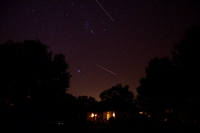
Orion Rises in a Winter Sky
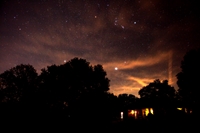
Orion Rises Through Clouds
|
A WINTER SKY RISES FROM MY BACKYARD
Orion Heralds A Winter Sky.
Top Picture:
Orion's belt points toward Sirius as the brightest nighttime star rises above the trees. Meanwhile airplanes also pass in the night sky.
Photo Details: Date: 2019 Nov. 30, 11:23 p.m. EST. Canon DSLR EOS 5D II, fixed mount. Canon EF 20-35mm USM, f/3.5-4.5 Lens at 20 mm, 20s @ f/4.0 (ISO 3200).
Bottom Picture: Clouds don't hide the rising brilliant stars of winter's sky. Can you find Orion with orangy Betelgeuse and bluish-white Rigel, brilliant Sirius in Canis Major, Procyon in Canis Minor and the stars of Gemini?
Photo Details: Date: 2019 Dec. 2, 11:14 p.m. EST. Canon DSLR EOS 5D II, fixed mount. Canon EF 20-35mm USM, f/3.5-4.5 Lens at 20 mm, 30s @ f/4.5 (ISO 6400).
|
|
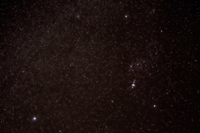 |
ORION IN WINTER SKY FROM SUBURBIA
ORION Appears Over S.W. Gainesville. Like photo below, this picture shows Orion and Sirius but taken from a suburban area only 8 mi. SW of the UF Campus. Yet numerous winter stars still show! Date: 2018 January 15,11:21 p.m. EST (Jan. 16, 04:21 UT). Photo Details: Canon DSLR EOS 5D II, fixed mount. Canon 50mm f/1.8 Lens. Exp. 60s @ f/4.5, ISO 1600. Image slightly trimmed from original. Click photo to enlarge.
|
|
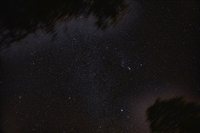
Photo #1: Unlabeled Version
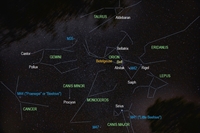
Photo #2. Labeled Version
|
BETELGEUSE DIMS 2020 JANUARY 20
Orion With Faint Betelgeuse. Betelegeuse (Alpha Orionid's) dimmed during late 2019 to early 2020. When brightest its mag. is about +0.5. Here it shines near mag. +1.6. Second photo is labeled. Third photo shows enlargement of three stars from Photo #1 to help compare their brightness. Click photos to enlarge.

Photo #3. Three Star Enlargement
|
|
Photo Details
Location: Gainesville, Florida,
8 mi. SW of the UF Campus
Date: 2020 January 20
Camera: Canon 5D II
Lens: Canon 20-35 f/3.5-4.5 USM at 20 mm
Mount: iOptron Star Tracker
|
Exposure: ISO 1600, f/4.5.
Stack of three 90 sec & four 75 sec.
At 9:37:28 – 9:46:56 pm EST (avg. time 9:42:12 pm EST)
|
|
|

Click Photo to Enlarge
or click here for labeled version
Click here for
largest resolution available
|
ORION OVER ROSEMARY HILL OBSERVATORY (RHO)
Orion Over Rosemary Hill Observatory Dome in February 2020. Orion and Canis Major appear in southern sky over the observatory dome of the University of Florida's 30-in. (0.76 m) f/5 reflecting telescope. Photo was taken at a star party hosted by the Alachua Astronomy Club.
Can you identify features? The stars Betelgeuse and Bellatrix (upper left and right), plus Saiph and Rigel (lower left and right) outline the great rectangle of Orion. Belt of Orion points to Sirius (Alpha Canis Major), nighttime's brightest star. Canopus (Alpha Carinae), nighttime's second brightest star, tries to shine from behind trees to right of building. (See labeled version.) Betelgeuse still remains fainter than normal but began to brighten in later weeks.
Light pollution has brightened horizon since telescope was installed in late 1960s. However, zenith sky remains reasonably dark. (Zenith distance of Sirius is 51°.) Limiting photo magnitude in Orion is about mag. +11.
Photo Details
Location: Rosemary Hill Observatory, Bronson, Florida
Date: 2020 February 22
Time: 7:38 p.m. EST (UT 12:38 Feb. 23) or 5 min. before end of astron. twilight
Camera/Lens: Canon EOS 5D II with Canon EF 20-35 mm, f/3.5-4.5, at 20 mm
Exposure: 75 sec at f/3.5, ISO 1600. Mount: iOptron Star Tracker Pro
|
|
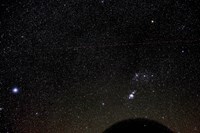
Also see Brief Video (56 sec.)
of Orion at Big Shoals
(Views alternate between
unannotated/annotated)
Note: Large File
May take several sec. to load
|
ORION IN A DARK SKY
Orion from Big Shoals State Park. Big Shoals State Park in North Florida has some of the darker skies in Florida. Here Orion is almost lost among the other stars of our Galaxy. Limiting magnitude is about +13 in this two minute exposure taken with digital camera piggy backed on clock driven refractor (unguided exposure). Telescope's dew cap is visible at bottom of photo where it partially obscures Rigel. Photo Date: 2014 March 1, 10:10 p.m. EST (March 2, 03:10 UT). Photo Location: Big Shoals State Park, Florida. Photo Details: Canon DSLR EOS 5D II, driven mount (unguided). Canon 50mm, f/1.8 lens. Exposure 120 sec at f/3.5 (ISO Equiv. 1600). Frame slightly cropped from original. Processed in Corel PaintShop Pro X5. Click image for both a larger and a labeled version.
|
|
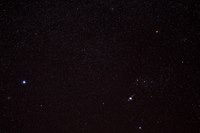
Click to Enlarge

Labeled Version
For comparison see
photo that simulates
naked eye view
(including labeled version)
|
ORION IN A SUBURBAN/CITY TRANSITION SKY
Orion Viewed from a Suburban Neighborhood. Unlike photo above from the dark skies of Big Shoals State Park, this picture was taken from the outskirts of Gainesville, Florida about 7 miles S.W .of the University of Florida Campus. City lights and especially lights from local street lights and neighboring houses with flood lights have severely crippled this night sky. Using Globe at Night Sky Maps for Orion, the estimated limiting visual magnitude was approximately +4.5. However, cameras, even old digital cameras as used here with an inexpensive 50 mm lens, still managed to reveal multitudes of stars.
This two minute exposure on a unguided tracking mount still shows stars down to about magnitude +10 to +11. This is not quite as faint as the photo above (similar exposure and lens) from Big Shoals State Park with a limiting magnitude two to three magnitudes fainter. But, the numerous stars here is still surprising considering the bright sky in this neighborhood. The Orion Nebula is easily seen. Also sharp eyes can spot the Open cluster (M41) south of Sirius and the Flame Nebula just above Alnitak (left star in Orion's Belt). See labeled diagram.
Photo Details:
Date: 2023 March 16, 8:41 p.m. EDT (March 17, 00:41 UT)
Location: Meadows of Kanapaha Subdivision, Gainesville, Florida
Camera: Canon DSLR EOS 5D II on iOptron ky Tracker Pro Mount (unguided)
Lens: Canon 50mm, f/1.8 lens
Exposure: 120 sec at f/4.5 (ISO Equiv. 1600)
Processed in Corel PaintShop Pro.
|
|
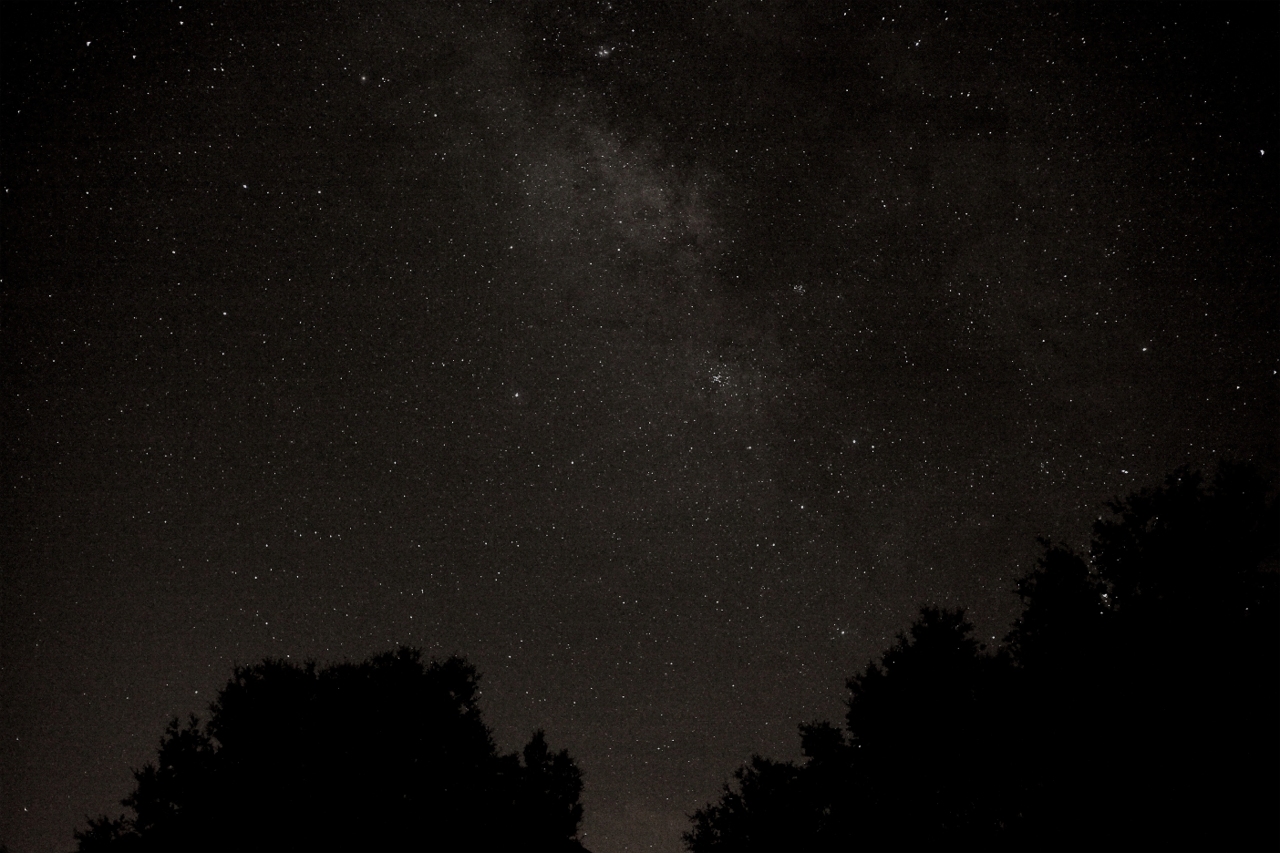 |
MILKY WAY FROM SUBURBIA
Summer Milky Way from Gainesville, Florida. Can you see the Milky Way from a small city? Gainesville, Florida, home of the University of Florida and Santa Fe College, is a small city in the region of North Central Florida (population about 125,00 within city limits; county population of approximately 250,000). It is also the largest city in this area and if you travel to its outskirts and avoid direct nighttime lighting, the Milky Way can still be glimpsed. The camera reveals more. Photo was taken about eight miles southwest of the university campus (Ben Hill Griffin Stadium) from a suburban community (2009 May 29). Location: Gainesville, Florida. Photo Details: Canon DSLR EOS 5D II, fixed mount. 50mm f/1.8 Lens, 4s @ f/2.8 (ISO Equiv. 6400). An even better version taken with a tracking mount under clear skies is below (Milky Way Again from a City's Suburban Home).
|
|
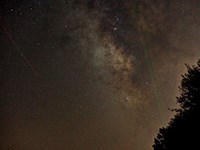 |
MILKY WAY IN RURAL SKIES
Milky Way from Stargate Observatory. Rural sites help bring out Milky Way although this North Florida country site still suffers from the lights of neighboring small cities. High humidity and murky skies plus lingering clouds also reduced transparency for this photo. Still, view toward center of Galaxy is breathtaking to camera. Can you find a major summer constellation in the picture? Click on thumbnail to enlarge and hover mouse over picture to see labeled version. Distorted star images in picture corners are not from trailing stars since camera was on a star tracking platform (iOptron iEQ30 mount). Instead, star images reveal comatic aberration in this mediocre lens! Location: Stargate Observatory, 7 mi (11 km) N.E. of Live Oak, Florida. Photo taken 2013 October 5 between 8:50 and 8:52 p.m. EDT (2013 Oct. 6, 00:50-00:52 UT). Photo Details: Canon DSLR EOS 5D II, equatorial tracking mount. 50mm f/1.8 Lens. Composite of 20s & 30s images @ f/2.8 (ISO Equiv. 1250) processed in Photomatix. Image slightly trimmed from original.
|
|
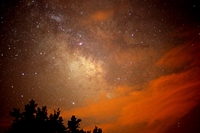 |
MILKY WAY FROM MURKY RURAL SKIES
Milky Way from Country Home. Short drives from Gainesville, Florida can produce moderately dark skies. This photo taken from a rural country home twenty-five miles N.W. of Gainesville between High Springs and Trenton should have shown these dark skies. Unfortunately, summer thunderstorms produced clouds, sheet lightning and murky skies. However, the summer Milky Way did partially show revealing Sagittarius and neighboring star clusters, nebulae and earthly clouds! Even through murky skies, the camera picked up stars as faint as magnitude nine to ten. Distorted star images in picture corners show comatic lens aberration and not from trailing stars since camera was on a star tracking platform. Location: Kelly Homestead, 25 mi (11 km) N.W. of Gainesville, Florida. Photo taken 2014 August 23, 9:49 p.m. EDT (2014 Aug. 24, 01:49 UT). Photo Details: Canon DSLR EOS 5D II, equatorial tracking mount. 50mm f/1.8 Lens. Exposure 30 sec. at f/1.8 ISO Equiv. 1600. Processed with Corel Paintshop and Canon Zoom Browser EX. Image slightly trimmed from original. See also larger version and labeled version.
|
|
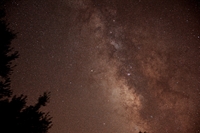 |
SUMMER MILKY WAY AGAIN FROM A CITY'S SUBURBAN HOME
Summer Milky Way with Star Clouds. North Florida residents do not yet need to travel very long distances to capture star studded skies. Unfortunately many areas of Florida are now brightly lit. However, people in the Gainesville area are more fortunate. Semi-dark skies are within an easy reach from this university city. This picture clearly shows Milky Way star clouds, nebulae and clusters captured from my backyard only 4.6 miles southwest of the I-75 and Archer Road Interchange (6.3 miles from the Oaks Mall and 7.8 miles from the UF football stadium). Limiting magnitude was probably again near 13th. Photo taken 2014 August 27, 9:50 p.m. EDT (2014 Aug. 24, 01:50 UT). Photo Details: Canon DSLR EOS 5D II, equatorial tracking mount. 50mm f/1.8 Lens. Exposure 90 sec. at f/3.5 ISO Equiv. 1600. Processed with Corel Paintshop. See also larger version and labeled version.
|
|
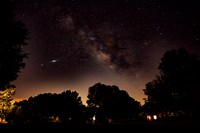 |
SUBURBAN MILKY WAY LANDSCAPE
Summer Milky Way with Jupiter and Saturn North Florida skies have become increasingly light polluted. Still, 2020 skies from southwest of the city can still reveal the glow of the summer Milky Way. From my driveway 4.6 miles southwest of the I-75 and Archer Road Interchange (7.8 miles from the UF football stadium), a tripod mounted camera shows the expanse of sky from Saturn and Jupiter (on left) through the Milky Way to Scorpius. (Jupiter's image suffers from lens flare.) Click photo to enlarge.
|
This is also not an especially fast lens and does not show as much detail as next photo. Can't identify constellations? Then see larger labeled version. This and next photo were made in 2020, about six years after photos of summer Milky Way made from same location (see above). Light pollution has increased since then but with care, photos show southern Milky Way can still be imaged. (Fortunately, southern sky faces away from Gainesville.)
Photo Details:
Date: 2020 June 22, Location: SW Gainesville Area
Camera: Canon SLR EOS 5D II, Lens: Canon EF 20-35 mm, f/3.5-4.5 USM, Focal Length at: 20 mm
Mount: Fixed Tripod, Stack Of Six Images, Exposures: 20 Sec at f/3.5, ISO 6400
Time: , 12:54:51 – 12:30:24 a.m. EDT (UT 04:54:51 – 04:30:24)
Processing: Corel Paintshop Pro, Field Approx.: 84° x 62°
|
|
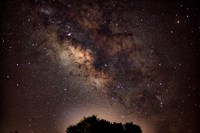 |
SUBURBAN MILKY WAY
Summer Milky Way Star Field Taken shortly before above picture, again on a tripod mount from same location. Picture taken with longer focal length so shows smaller field of view but this is a faster lens so image has more detail. (Lens is an inexpensive 50 mm so star images at edges clearly show lens aberrations.) Stars also slightly streaked since not on a driven mount. Click photo to enlarge. Can't identify constellations? Then see larger labeled version that identifies some of the many clusters and nebulae in this region.
|
Photo Details:
Date: 2020 June 22, Location: SW Gainesville Area
Camera: Canon SLR EOS 5D II, Lens: Canon EF 50 mm, f/1.8 USM, Focal Length at: 50 mm
Mount: Fixed Tripod, Stack Of Five Images, Exposures: 6 Sec at f/2.0, ISO 6400
Time: 12:06:06 – 12:06:39 a.m. EDT (UT 04:06:06 – 04:06:39)
Processing: Corel Paintshop Pro, Field Approx.: 39.6° x 29°
|
|
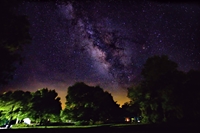
Click photo to enlarge.
Then put cursor over larger version (opens in new window)
to identify constellations and
some of the many clusters and nebulae in this region
|
SUBURBAN MILKY WAY AGAIN
Summer Milky Way Star Field Light pollution by 2022 now makes seeing the bright southern Milky Way difficult with the naked eye. However, even an old DSLR can still capture some of its beauty.
Compare with photo above (Summer Milky Way Again From A City's Suburban Home) taken about six years before with a faster lens (50mm, f/1.8) but with same f-stop as here (f/3.5) and a single 90 sec. exposure rather than five stacked, 30 sec. exposures.
Photo Details:
Date: 2022 June 23
Location: SW Gainesville Area
Camera: Canon SLR EOS 5D II
Lens: Canon EF 20-35 mm, f/3.5-5.6 USM, Focal Length at 20 mm
Mount: iOptron Star Tracker Pro
Stack Of Five Images, Exposures: 30 Sec at f/3.5, ISO 1600
Time: 01:01:11 – 01:02:25 a.m. EDT (UT 05:01:011 – 05:02:25)
Processing: Corel Paintshop Pro (Trimmed to 2x3)
|
|
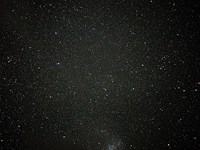 |
SKY FROM DOWN UNDER
Dark Skis from Australia. Modern digital cameras can do wonders on night skies. (See above picture taken from a suburban USA location.) But dark skies can do more. This photo was taken from Fitzroy Island, 18 mi. (29 km) off the coast of Cairns, Queensland, Australia. Although not as dark as outback sites and lit somewhat from the island's resort, skies are darker than most USA suburban areas. Photo taken 2012 November 16 11:16 p.m. EST (Australian Eastern Standard Time). Location: Fitzroy Island, Queensland, Australia. Photo Details: Canon DSLR EOS 5D II, fixed mount. 50mm f/1.8 Lens, 15s @ f/2.0 (ISO Equiv. 6400).
|
|
 |
ORION FROM DOWN UNDER
Orion Lying on His Back. Orion (the "Hunter") is one of the skies brightest and most conspicuous constellations. However, northern hemisphere observers may have trouble identifying him from southern hemisphere locations where he is turned over. The black void in the upper right hand corner is from a passing cloud. Look for the three stars marking his belt and the Orion Nebula in his sword. Photo taken 2012 November 16 at 11:14 p.m. EST (Australian Eastern Standard Time). Location: Fitzroy Island, Queensland, Australia. Photo Details: Canon DSLR EOS 5D II, fixed mount. 50mm f/1.8 Lens, 15s @ f/2.0 (ISO Equiv. 6400).
|
|
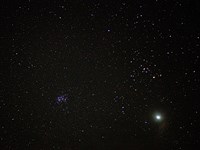 |
STAR FIELD WITH PLEIADES FROM DOWN UNDER
Northerners should recognize this famous, naked-eye star cluster in Taurus, the Pleiades or "Seven Sisters." in the lower left part of this photo. Southern observers can also see this cluster. Bright Jupiter appears to the lower right with the Hyades Star Cluster above. Photo taken 2012 November 16 at 11:27 p.m. EST (Australian Eastern Standard Time). Location: Fitzroy Island, Queensland, Australia. Photo Details: Canon DSLR EOS 5D II, fixed mount. 50mm f/1.8 Lens, 8s @ f/2.0 (ISO Equiv. 6400).
|
|
 |
SMALL MAGELLANIC CLOUD
Deep in Southern Skies. This dwarf irregular galaxy in the constellation of Tucana (the "Toucan") is a sight not seen from most northern locations due to its nearness to the South Celestial Pole. Along with the Large Magellanic Cloud (LMC), next picture, the Small Magellanic Cloud (SMC) is one of the most sort after celestial objects for visitors to the Southern Hemisphere. Although the SMC may look like a detached piece of the Milky Way to the naked eye from a dark site, the SMC is really a separate, but close neighboring galaxy to our own. Its distance (200,000 light years) is about 25% farther than the LMC and its smaller diameter (about half the LMC) both make the SMC appear smaller than the LMC. The great globular cluster, 47 Tucanae, which belongs to our own Milky Way Galaxy, lies to its right. Location: Fitzroy Island, Queensland, Australia. Photo Details: Canon DSLR EOS 5D II, fixed mount. 50mm f/1.8 Lens, 15s @ f/2.0 (ISO Equiv. 6400).
|
|
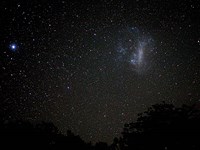 |
LARGE MAGELLANIC CLOUD
A Jewel of Southern Skies. Like the Small Magellanic Cloud (above picture), visitors to southern skies list the Large Magellanic Cloud (LMC) as a must see celestial object. This patch of light borders the constellation of Dorado (the "Swordfish") with extensions into Mensa (the "Table"). In dark skies, this nearby irregular but complex galaxy (a dwarf spiral?) can be mistaken for an earthly cloud. (Its real diameter of 14,000 light years appears to span more than twenty moon diameters from Earth.) This satellite galaxy of our own Milky Way is about 160,000 light years away, closer than the SMC. The Tarantula Nebula (30 Doradus), visible in the lower left part of the LMC, is one of the largest star forming regions known. The sky's second brightest star, Canopus, appears at the right edge. See next picture. Photo taken 2012 November 16 11:20 p.m. EST (Australian Eastern Standard Time). Location: Fitzroy Island, Queensland, Australia. Photo Details: Canon DSLR EOS 5D II, fixed mount. 50mm f/1.8 Lens, 15s @ f/2.0 (ISO Equiv. 6400).
|
|
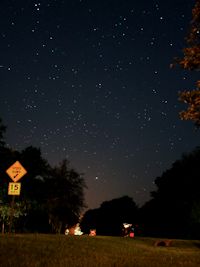 |
CANOPUS
A Star Too Low. Although second brightest of the nighttime stars, Canopus in Carina (the "Keel,"), is a beautiful, mysterious star mostly unknown to many observer's in the Northern Hemisphere. This star lies deep within the southern sky within a constellation once part of a larger grouping, Argo Navis (the ship "Argo"). Hence, this star remains near or below the horizon for much of the continental USA. However, Canopus can be easily, though briefly glimpsed, low in winter southern skies from Florida and southern Texas. In North Florida, for example, the star reaches a maximum altitude of only about 7 degrees and is visible at most for approximately five hours. Although whitish, it is usually dimmed by horizon haze and may twinkle madly from atmospheric effects. But, from Australia, this star shines brightly high above the horizon. (See previous picture of the LMC).) In this photo from North Florida, Canopus appears low near bottom center between the line of trees. Be sure to read, Have You Seen Canopus Tonight?, an article about this wonderful star. See also photo below. Photo Location: Gainesville, Florida. Photo Details: Canon DSLR EOS 5D II, fixed mount. Canon EF 28-135mm IS USM, f/3.5-5.6 Lens at 70.0mm, 20s @ f/5.0 (ISO Equiv. 6400).
|
|
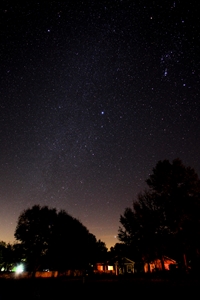 |
CANOPUS AND ORION IN SUBURBAN SKY
Second Brightest Dimmed by horizon lights and haze, Canopus still shines bright near upper transit, only 7.8 degrees above the southern Gainesville winter horizon. Orion appears at upper right with belt pointing at Sirius, brightest nighttime star. Meanwhile, directly below Sirius is Canopus, peaking through dip in trees. Procyon shines in upper left of photo. Though photo taken only 8 mi. SW of UF campus, numerous winter stars appear. Winter Milky Way, though dim, stretches upward between Sirius and Procyon. Click photo to enlarge. Photo Location: Gainesville, Florida. Date: 2018 January 15, 11:35 p.m. EST (Jan. 16, 04:35 UT). Photo Details: Canon DSLR EOS 5D II, tracking mount. Canon EF 20-35mm f/3.5-4.5 USM Lens at 20mm. Exp. 60s @ f/4.5, ISO 1600).
Also see Trimmed and Enlarged Version of this picture with Canopus above tree line.
|
|
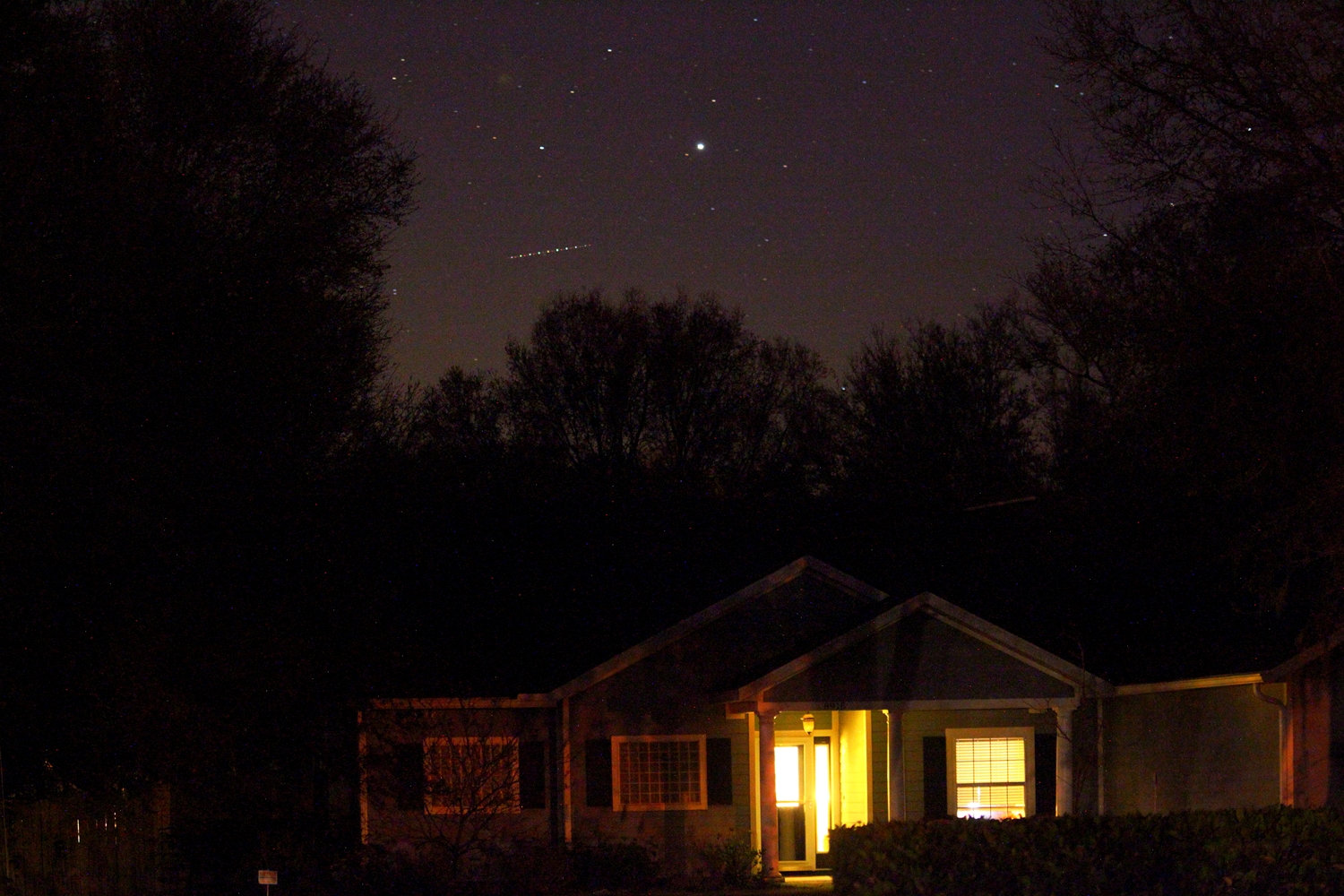 |
CANOPUS AND AIRPLANE
Canopus Swings Low Trailed by Airplane From Gainesville in North Florida, this brilliant type A9 supergiant (distance about 300 light years) is never higher than about 7.8 degrees altitude (7.0 degrees above the southern horizon in this photo). Here on a late winter evening, airplane lights follow Canopus. A clear, southern horizon needed to spot this beauty which is not visible from latitudes farther north than southern Georgia. Click photo to enlarge. Photo Location: Gainesville, Florida. Date: 2018 March 13, 9:20 p.m. EDT (Mar. 14, 01:20 UT). Photo Details: Canon DSLR EOS 5D II, stationary mount. Canon EF 100-400mm f/4.5-5.6 IS USM Lens at 400mm with Canon 1.4x converter. Exp. 10s @ f/6.7, ISO 6400).
|
|
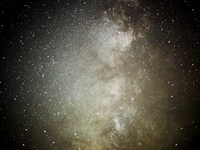 |
A SAGITTARIUS-SCUTUM MILKY WAY
Summer Milky Way Lingers at RHO. By mid-fall in Florida the last remnants of the summer Milky Way lingers over the southwestern horizon in early evening skies. Photo taken at an AAC Star Party at the University of Florida's Rosemary Hill Observatory (RHO). Can you find the handle of the Sagittarius "Teapot" (lower left)? Photo Date: 2014 October 25, 9:10 p.m. EDT (October 26, 00:10 UT). Although RHO now suffers from light pollution, limiting magnitude is about +12 to +13. Photo Location: Rosemary Hill Observatory, Bronson, Florida. Photo Details: Canon DSLR EOS 5D II, driven mount (unguided). Canon 50mm, f/1.8 lens. Exposure 60 sec at f/2 (ISO Equiv. 1600).
|
|
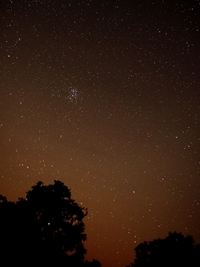 |
PLEIADES RISING
The Seven Sisters Star Cluster Over Gainesville Lights. While the Summer Milky Way sets in early evening skies during a Florida October night (see Sagittarius-Scutum Milky Way above), the Fall Winter Sky rises in eastern skies. Photo taken at an AAC Star Party at the University of Florida's Rosemary Hill Observatory (RHO). Here the Pleiades Star cluster tries to rise out of the bright eastern sky due to increasing light pollution from Gainesville, Florida about twenty miles to the northeast. Yellowish Aldebaran in Taurus shines through the trees (lower left). Photo Date: 2014 October 25, 9:44 p.m. EDT (October 26, 00:44 UT). Photo Location: Rosemary Hill Observatory, Bronson, Florida. Photo Details: Canon DSLR EOS 5D II, driven mount (unguided). Canon 50mm, f/1.8 lens. Exposure 20 sec at f/2.5 (ISO Equiv. 1600).
|
|
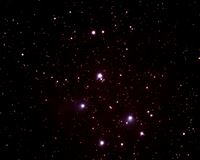 |
PLEIADES STAR CLUSTER
The Seven Sisters (M45). Taken from grounds of the Rosemary Hill Observatory, Bronson, Florida during an Alachua Astronomy Club star party. For details and larger images click photo or here. (This Pleiades picture is on the RHO Picture Pages.) Photo Date: 2015 Feb. 21.
|
|
 |
PRAESEPE STAR CLUSTER
The Beehive Cluster (M44). Taken from grounds of the Rosemary Hill Observatory, Bronson, Florida during an Alachua Astronomy Club star party. For details and larger images click photo or here. (This Praesepe picture is on the RHO Picture Pages.) Photo Date: 2015 Feb. 21.
|
|
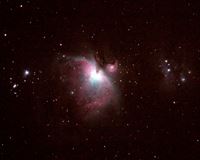 |
ORION NEBULA
The Great Orion Nebula (M42). Taken from grounds of the Rosemary Hill Observatory, Bronson, Florida during an Alachua Astronomy Club star party. For details and larger images click photo or here. (This Orion Nebula picture is on the RHO Picture Pages.) Photo Date: 2015 Feb. 21.
|
|

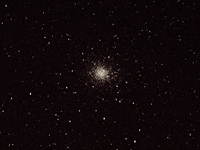
|
OMEGA CENTAURI
The Great Globular Cluster in Centaurus (NGC 5139). This gorgeous globular cluster in the constellation of Centaurus is usually thought to be out of reach from the mainland USA due to its large southern declination of -44.7 degrees. In fact, one typically hears this cluster is only visible to southern observers. However, this brightest of all observable globular clusters can be observed even from North Florida by knowledgeable sky watchers as seen here though both photos taken under very murky sky conditions. Top photo includes inset made from the photo.
Photo Details (Top): Canon DSLR EOS 5D II, Canon EF 28-135mm IS USM, f/3.5-5.6 Lens at 115mm, 30s @ f/5.6 (ISO Equiv. 3200). Photo Details (Bottom): Canon DSLR EOS 5D II on Tele Vue 76mm, f/6.3 APO refractor, 75s @ f/6.3 (ISO Equiv. 1600). Both images trimmed from originals. A finding chart showing location is here. (Chart drawn for a North Florida mid-June evening but should be useful for other locations and times.)

|
|
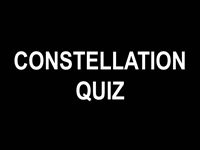
|
CONSTELLATION QUIZ
Five Photos Contain Well-Known Constellation Patterns. Think you know the constellations? Up to a challenge? Try to identify constellations in these five sky photos taken with a 50 mm focal length lens at an Alachua Astronomy Club star party 2016 October 1/2 in North Florida. The large number of stars makes this difficult!
Click Image on Left or Click Here for Quiz.
|
|
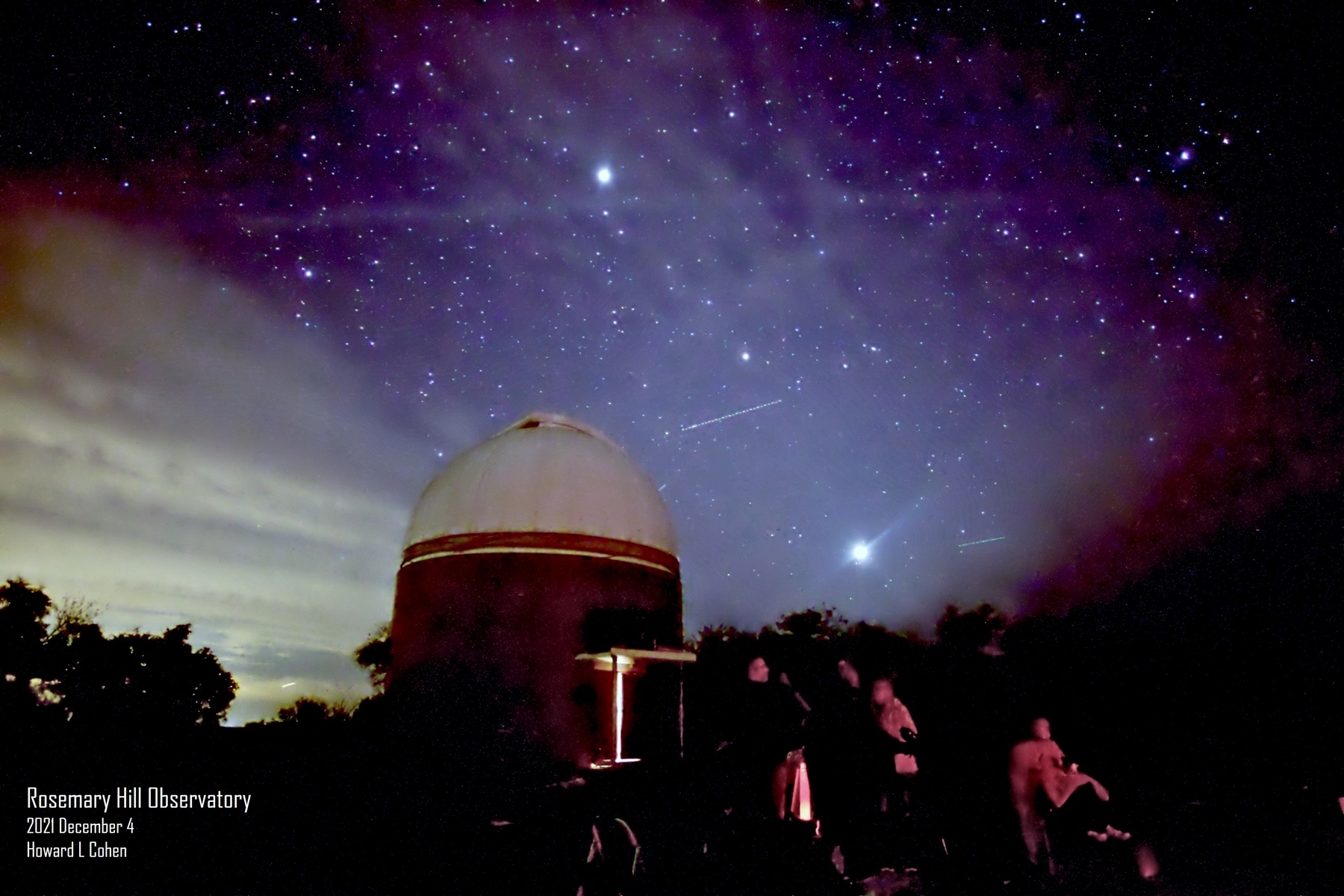 Click Image to Enlarge.
Click Image to Enlarge.
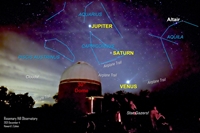
Labeled Version
Click Image to Enlarge.
|
AN EVENING AT RHO
Three Planets Shine in Murky Skies. The Alachua Astronomy Club met December 2021 for its first in person gathering since the Covid pandemic began for a star party at the University of Florida's Rosemary Hill Observatory instead of its annual holiday party. Cloudy and hazy skies prevailed but occasional murky holes appeared in the cloud cover allowing some star gazing.
Here we see three planets (Venus, Saturn and Jupiter from lower right to upper left center) gathering in southwestern skies shinning among autumn stars and thin clouds. (See unlabeled and labeled versions.) The observatory's dome housing a 30-in. reflector with star gazers appear in the foreground. Venus was near greatest brilliancy at magnitude -4.7, Saturn at mag. +0.7 and Jupiter at mag. -2.3.
Photo Details:
Location: Rosemary Hill Observatory, Bronson, Florida
Date & Time: 2021 Dec. 4/5, 7:07 p.m. EST
Camera: Canon EOS 5D II on Fixed Mount
Lens: Canon EF 20-35mm USM, f/3.5-4.5 at 20 mm
Exposure: 15 sec, f/3.5, ISO 5000
(Processed with Corel Paintshop Pro)
|
|
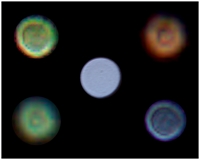
Enlarged Images of the Bright Stars Canopus and Sirius
Above are highly magnified stellar images showing influence of astronomical seeing, instrumental effects and exposure.
(Click image to enlarge.)
Date: 2018 March 13
Details: Camera Canon EOS 5D II. Lens 100-400 mm IS USM, f/4.5-5.6 at 400 mm with 1.4x Canon Converter.
Canopus:
Left Top and Bottom, Right Top
Sirius:
Right Bottom and Center (very out of focus)
|
SEEING
Seeing Effects on Star Images.
Celestial images are influenced by random atmospheric turbulence, instrumental effects and image motions resulting from normal celestial motions, or eye pupil movements. These can produce interesting and sometimes puzzling sights. Overly magnified star images can exhibit weird looking stars due to refraction and dispersion of starlight that produces blurring, flickering, image motion, weird geometrical shapes, and an array of colors. Some photos also showed various optical aberrations (e.g., "donuts" or "ghost" images), a function of optical design. Exposure times, instrumental physical and optical parts also come into play helping to produce weird looking stars. In addition, clouds, haze and decreasing transparency of the air often make stars and planets dramatically twinkle and even disappear when near the horizon.
Astronomers are very familiar with all these effects and use the technical term "astronomical seeing" when discussing the blurring and twinkling of stars due to turbulent mixing of air. These "seeing effects" vary from day to day, hour to hour. One's surroundings (e.g., warm roads or buildings) can also influence seeing and will worsen for objects near the horizon.
Most people are ignorant of astronomical objects and these related atmospheric phenomena. Therefore, they may assert a celestial object is definitely not a star or planet and then claim to have witnessed some strange or mystical event! Some may even use these images to deceive people into thinking they are seeing something mystical when they are not. However, these images are usually just "normal stars" doing what they should be doing when subject to bad astronomical seeing, instrumental and exposure effects, and the normal motions of the sky.
Also see this short, 4-1/2 minute YouTube Video illustrating astronomical seeing effects on Canopus.
|
|

Can You ID Star Patterns?
(Click Image to Enlarge)
Labeled Version Here
BUT DO NOT CHEAT!
Try to ID Star Patterns First
Need a Clue?
Here is View of Well-Known
Double in One of the Star Patterns
|
WHEN THERE ARE TOO MANY STARS
Can You Identify These Very Common Star Patterns in a Very Dark Sky? Making star patterns or constellations help navigate the night sky but in very dark locations too many stars can hide even the more conspicuous constellations.
This photo was taken from The University of Florida's Rosemary Hill Observatory on an April 2022 evening at an Alachua Astronomy Club Star Party. (Limiting magnitude about mag. +9.5 or about 16x fainter than naked eye limit of +6.5.)
Can you find at least two wildly known star patterns and a famous star!
DO NOT CHEAT! Then see labeled photo for answer.
Also See Short MP4 Video, "When There Are Too Many Stars" (or see on YouTube).
Photo Details:
Location: Rosemary Hill Observatory, Bronson, Florida
Date & Time: 2022 April , 10:03-10:14 p.m. EDT
Camera: Canon EOS 5D II on Fixed Mount
Lens: Canon EF 20-35mm USM, f/3.5-4.5 at 21 mm
Mount: iOptron SkyTracker™ Pro
Exposure: 8m51s sec (stack of 8), f/4.5, ISO 1600
|
|
|